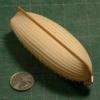-
Posts
13,300 -
Joined
-
Last visited
Content Type
Profiles
Forums
Gallery
Events
Everything posted by druxey
-
Nicely done, Eric. I bet you are glad that the buckets aren't feathering ones!
- 599 replies
-
- sidewheeler
- arabia
-
(and 4 more)
Tagged with:
-
I assume you must mark the positions of the drainage holes very carefully before cutting them off the model! Beautiful work, Daniel.
-
I suspect the definitive scheme still needs to be written - by you, Allan!
-
Fair winds to Albertic, Michael! That was a magnificent restoration saga and result.
- 749 replies
-
- albertic
- ocean liner
-
(and 2 more)
Tagged with:
-

Byrnes Table Saw Tips (requested)
druxey replied to Matrim's topic in Modeling tools and Workshop Equipment
I've used both methods. However, it's quicker if one does not have to re-set the fence after each cut. The warning of ensuring adequate blade/guide clearance cannot be repeated too often! -
A nice subject. Looks like you are off to a good start.
- 589 replies
-
- le gros ventre
- cargo
-
(and 1 more)
Tagged with:
-

Brig USS Enterprise 1799 info gathering
druxey replied to CharlieZardoz's topic in Nautical/Naval History
Ian: It's the Chapelle draught of the 14 gun unidentified schooner (post #124) that has station lines at right angles to the keel. The Salvini one does not. -
Well done and well finished, Toni. The display stand is very good: it does not detract from the model. Congratulations, and on to ??
- 1,449 replies
-
Well, welcome aboard, Ab! Glad you could join us. It's great to be able to communicate with you: I wanted to say how impressed I was with the Rijkmuseum when I visited last year. The holographic animation of the half-hull model was superb! Hopefully it will inspire younger visitors to look more closely at the other models on display.
-
I agree that sometimes, lacking a time machine or specific evidence to the contrary, 'best guess' after extensive research must make do. Annoying for those of us with OCD, but necessary!
- 3,618 replies
-
- young america
- clipper
-
(and 1 more)
Tagged with:
-
One on each side athwarthips, I believe.
-
I use 90% (or higher percent) rubbing alcohol (isopropanol) for dissolving PVA, not meths!
- 740 replies
-
- Tudor
- restoration
-
(and 4 more)
Tagged with:
-
Exactly, Ed. Stressing the joint before it is fully dry invites failure. How do I know this?
- 3,618 replies
-
- young america
- clipper
-
(and 1 more)
Tagged with:
-

Yamaha MT-01 by Dan Vadas - CARD - FINISHED
druxey replied to Dan Vadas's topic in Non-ship/categorised builds
Mad, I tell you, mad.... Well done, Dan. -
Well played, sir! I have occasion to splice lines in place. A fairly imperceptible way is to fray the ends to be joined by separating out the strands and 'combing' them, them cutting them diagonally. A small wood block in one hand and a sharp scalpel blade in the other achieves this. A small amount of white glue on one end and (with clean, dry fingers) roll the two ends together to make a nice tapered together faux splice. Once you have the technique down, it is a reliable and surprisingly strong method of 'splicing' at small scale. I use this technique extensively for eye splices as well: they hold nicely under tension.
- 3,618 replies
-
- young america
- clipper
-
(and 1 more)
Tagged with:
-
A very well put-together video. Just don't set your planes down on their soles as the guy did with some near the end.
- 13 replies
-
- rabbet
- bearding line
-
(and 4 more)
Tagged with:
About us
Modelshipworld - Advancing Ship Modeling through Research
SSL Secured
Your security is important for us so this Website is SSL-Secured
NRG Mailing Address
Nautical Research Guild
237 South Lincoln Street
Westmont IL, 60559-1917
Model Ship World ® and the MSW logo are Registered Trademarks, and belong to the Nautical Research Guild (United States Patent and Trademark Office: No. 6,929,264 & No. 6,929,274, registered Dec. 20, 2022)
Helpful Links
About the NRG
If you enjoy building ship models that are historically accurate as well as beautiful, then The Nautical Research Guild (NRG) is just right for you.
The Guild is a non-profit educational organization whose mission is to “Advance Ship Modeling Through Research”. We provide support to our members in their efforts to raise the quality of their model ships.
The Nautical Research Guild has published our world-renowned quarterly magazine, The Nautical Research Journal, since 1955. The pages of the Journal are full of articles by accomplished ship modelers who show you how they create those exquisite details on their models, and by maritime historians who show you the correct details to build. The Journal is available in both print and digital editions. Go to the NRG web site (www.thenrg.org) to download a complimentary digital copy of the Journal. The NRG also publishes plan sets, books and compilations of back issues of the Journal and the former Ships in Scale and Model Ship Builder magazines.


